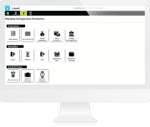Integrated business planning … “Integrated” is one of those words that might mean anything. Time to add a little more detail. What do we mean by this and what can integrated business planning look like?
So what is Integrated Planning? TLDR;
Integrated planning simply describes the combination of planning processes from different areas. We all know this from everyday life – take shopping, for example: you make a shopping list, a goods plan so to speak, buy everything and then realise that you don’t have enough space in the back of the car because there’s still a sports bag in there. So you cram around like mad.
Wouldn’t it be cool if the shopping list told you that there was no room for the 60 pound Halloween pumpkin in the boot? And imagine if the list also calculated whether there’s enough room in the fridge, how much it all costs, how it fits into your household budget, who will be at home to help unpack when you return and whether you and your family can even eat that much pumpkin soup.
Integrated business planning aims to do just that – for businesses.
Integrated Business Planning
Integrated Business Planning
In contrast to the example above, integrated business planning, sometimes also called holistic business planning, sets a relatively clear frame of reference. After all, the planning context must be organisationally feasible, legally compliant, economical and helpful – accordingly, there is usually a clear hierarchy with regard to the desired integrations … which does not mean that not everything can or should be integrated – just not everything at the same time.
1. Finance
“No dough, no party”, which is why financial planning should be the first to be equipped with a planning application. After all, everything has to be integrated somewhere. As the “heart of the company”, the finance department must reach all areas – and is therefore perfectly suited. A BI or EPM solution provides financial controllers with the necessary overview and validates the financial data. This is enormously helpful in itself, but at the same time this approach also forms the basis for integrated business planning.
2. Human Resources / People Operations
We usually recommend putting the HR / People department in second place when it comes to integration. And no, our recommendation is not always met with cheers. The background is as follows: HR departments are notoriously under-digitised, so the ROI in this area is particularly high, especially because personnel is often the largest cost centre. In addition, the workforce is the backbone of every company, and flexible personnel planning with forecasts and vacancy planning has an impact on almost all company processes – similar to finance.
Nevertheless, many companies prefer to digitise core processes first, but in the end it is a question of philosophy – are your positions filled redundantly, do you have no vacancies and are staff shortages not a problem for you? Then go ahead and start with your …
3. Core processes
Depending on the industry, the relevant core processes should now be integrated into the solution. In the manufacturing industry, comprehensive procurement planning is a good option, while in the retail sector, dedicated merchandise financial planning on a weekly basis (WSSI) is ideal. You should also consider solutions for supply chain management (SCM), production or sales.
The main aim of integrated business planning is to reduce media disruptions and isolated solutions and form the famous interface. One result could be, for example, automated cost calculation in the quotation process – as a sales solution with data from procurement planning and SCM. In the energy sector and in many contract-based models in general, a planning and analysis platform supports you in churn management with a cohort analysis, for example.
Why individual steps at all?
Ambitious digitisation projects take time. In over 15 years of implementation work, we have learnt that parts of the solution are released for use before the overall solution is completed, users are more involved. This is another reason why projects with bdg generally have very good adoption rates. Users learn to work with parts of the solution while it is still being implemented – which is obviously a much better starting point for exploring newly connected data systems without being overwhelmed by an excess of functions.

Advanced: Example of Integrated Business Planning
Let’s assume you have set up an integrated corporate planning solution in your company. What would planning look like?
Going back to the shopping example from above, but taking the perspective of the retailer where you bought your 60 pound Halloween pumpkin. So you’re in the management team of this retailer and you realise: there’s a blind spot on the map in an up-and-coming part of town where your business should definitely have a store. Now you plan to set up a new location from scratch.
First step: market research. You find out how big your location needs to be to serve the region. Then you look in your application and search for an existing location of a comparable size. The application immediately shows you all the important data about the location: how many staff work there? What does the P&L look like? What procurement plans are in place and how is the location supplied?
To start with, you can confidently plan the new location with the same data – you will only need to adjust the details. Let’s start with personnel planning. You plan how many employees the location should have and in which salary bands the personnel costs lie, or in which pay scale classes. The calculated costs are immediately and automatically included in your financial planning for the new location, including pay scale adjustments and salary increases.
The next step is procurement planning: how is the location supplied and what additional costs are incurred? The procurement costs are also automatically included in your financial plan and create a G/L account-related cost centre there. With the data fed in, you switch to the finance part of your application and can now simulate a P&L for the new location. Take a look at the forecast, have you been too optimistic? Adjust the forecast a little, you never know these days, simulate the worst-case scenario. The worst case would be ruinous? No worries, you could just adjust the parameters a bit, maybe a little less space will do? Change the parameters, import the data, simulate the forecast – repeat.
You can now report your analyses and forecasts directly from the application and present them at the next board meeting. I guess it’s easy to see the value of integrated planning with forecasts in a high-risk scenario, but of course the added value will come into play whenever you want to plan, analyse or report.
Conclusion: Integrated corporate planning works!
Integrated business planning ensures that you can adapt to changing environments and act rather than react. With flexible framework solutions as a software basis, any operational process can be mapped. Feel free to get in touch with us.













